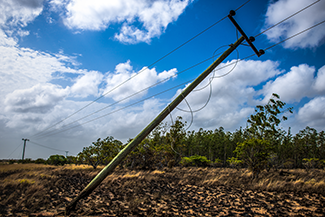Protecting Your Home and Family with Emergency Preparedness Plans
Let's Update the Family Emergency Preparedness Plans
Most of the time our weather in Arizona is predictable with lots of sunshine and clear skies. But, every year during our two wet seasons of late summer and January/February, floods occur. Along with the floods come reports of loss of life and property. People who are new to Arizona often are not prepared for these events and do not have a backup plan.

People are often surprised by the scope of damage floods in Arizona can cause. Over the years there have been many notable floods.
- The Great Flood of Arizona occurred in February 1891. The Salt River swelled to 18ft deep and 3 miles wide. The flood took the Tempe railroad bridge with it and swept away homes.
- The Winter Floods of 1993 brought record rainfalls and record water flow throughout the state. The losses included the Gillespie Dam in Phoenix and the Mill Ave Bridge in Tempe. Pima county experienced major flooding that isolated 1,000's of people in their homes and the dike broke in Duncan leaving 150 people homeless.
In addition to mega storms, localized flooding of roads and washes is a common occurrence during seasonal rains and just as dangerous if not regarded with respect!
- September 9th, 2014 Mesa was cut off from the rest of the city as the remnants of a tropical hurricane sent 5.5 inches into Phoenix, causing Mesa to flood.
- In 2018 the I-10 was closed in both directions as flood waters covered the highway at the 43rd Ave exit. Cars were abandoned in the middle of the highway as people escaped to higher ground.
Plan and be Prepared!
Preparing to Shelter In Place At Home
 If a monsoon storm is in your area, uphill from you or on its way, stay home if you can. Avoid the risk of flooding streets and downed power lines by waiting for the storm to pass. Arizona storms generally pass quickly.
If a monsoon storm is in your area, uphill from you or on its way, stay home if you can. Avoid the risk of flooding streets and downed power lines by waiting for the storm to pass. Arizona storms generally pass quickly.
It pays to think through emergency situations before they happen. It is even better to take it one step further and prepare for those emergencies. Make a plan and share it with the family, making sure everyone is on the same page.
The majority of us have never faced a major crises or natural disaster that has left us without local resources! If you need help thinking through what might be needed for an emergency, check out Romey's "List of Lists" that he has put together for emergency situations. Each category listed has the basic components for consideration with a link to a full resource guide.
Preparing to be Stranded with Your Vehicle
 Never cross flowing washes. Never. The flow of water will subside in time and there will be a better time to cross.
Never cross flowing washes. Never. The flow of water will subside in time and there will be a better time to cross.
Keep a bug out bag in your vehicle. This is a bag equipped with everything you might need should you need to wait out a flooded road crossing, monsoon dust storm or experience a vehicle breakdown.
Romey's guide for vehicle preparedness is complete with a list of items to have for your vehicle and for the occupants. The list for the vehicle includes just about everything you can think of for your vehicle in an emergency. Always have a map or Arizona Atlas and Gazetteer in your car as GPS and cell services could be down during a storm.
Protecting Your Home with Flood Insurance | Check Your Policy!

Your home insurance policy will not cover flash flooding. In fact, if water enters your home from the outside, it will not automatically be covered. It doesn't matter whether the water is from flash flooding or a neighbor who accidentally diverted water to your yard, any water or mud damage in your home will not be covered unless you bought flood insurance. "If you're in a possible flood plain, you're eligible for federal flood insurance and your mortgage company will require you to buy it," says Clay Jansen of Rosie Certified Phocus Insurance Group. The price varies depending on the kind of risk your home has.
Before buying a home, check with your Realtor. You might also want to check the National Flood Insurance Program Web site by FEMA (www.floodsmart.gov ) to see what the risk is in your area.
Insurance for Other Causes of Flooding:
Flooding caused by broken pipes in your home or a connection that breaks like a washing machine, water heater or dishwasher is generally covered by homeowner insurance. Severely neglected pipes that have experienced breakage and leakage, like the galvanized pipes found in homes that are 50+ years, probably would not be covered.
Home Maintenance To-Do: #FlashFlood
###
Photo Credits:
- Shutterstock
- Fox Valley Electric
RELATED CONTENT:
- Resource: Flood Zone Map
- DIY FAQ: Must Haves When Leaving The House
- DIY FAQ: What Do I need To Know About Home Insurance?
- DIY FAQ: Four DIY Projects That Help Pay For Themselves
- Podcast: What You Need to Know to Buy a Light Bulb
